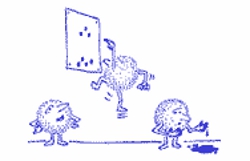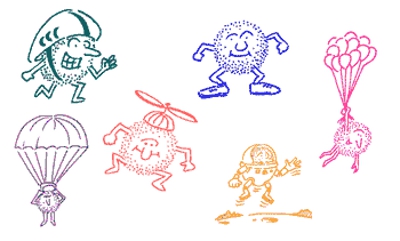Lesson: How High Can You Fly?
(Lesson courtesy of Smithsonian Education).
Download the Original Lesson in .PDF Form
In this lesson, you’ll introduce your students to the four forces of flight–drag, lift, thrust, and weight–through a variety of fun-filled flight experiments. Students will “fly” for short periods and then evaluate factors that might either increase or decrease their “flight” duration.
You might begin the activity by asking your students the following questions:
- Can you fly? How high do you think you can fly? How long do you think a very good jumper (e.g., Michael Jordan) can stay in the air?
- Have your students complete the “How High Can You Fly?” and “How Long Can You Fly?” exercises. Ask them to examine the duration and height of their flights. Are they surprised at the results?
- Refer to the “Think About It” exercise. Ask your students to observe each of the cartoon figures. What are they doing? How might the cartoon figures’ actions and environments allow them to jump higher and for longer periods than anyone in class? What else could students do to make their jumps last longer?
Look, Mom, No Wings!
Do you ever dream of being able to fly? The good news is, you probably can! The bad news is, you cannot fly very high or stay up very long.
HOW HIGH CAN YOU FLY?
Materials
- Large sheet of paper
- Tape
- Dirt or stamp pad
- Ruler or meter stick
How high do you think you can jump? Get some of your friends together to find out.
- Tape a large piece of paper to the wall. (Brown wrapping paper or sheets of newspaper will do.) The shortest person in your group should be able to reach the bottom of the paper without standing on tiptoes.
- Dip one finger in dirt or ink. While standing with your feet flat on the floor, stretch your arm as far as you can and mark the highest point you can reach on the paper.
- Now jump and mark the paper by touching it at the top of your jump. Try it a few times and challenge your friends to jump higher. (Label each person’s standing and jumping marks with initials or have each person use a different color of ink or dirt.)
- Use a ruler or meter stick to measure the vertical difference in height between your standing and jumping marks. This is how high you can jump. Surprised?
HOW LONG CAN YOU FLY?
Materials
- One helper
- Stopwatch or watch with a second hand
How long can you stay in the air when you jump? Ask someone to time you with a stopwatch or a watch with a second hand. (It won’t be easy!) You can also time jumping athletes who are playing sports such as basketball or volleyball.
Some other possible actions to make jumps last longer
- Lift – Wear wings.
- Thrust – Jump off a trampoline or diving board; launch yourself with a pole vault, catapult, or rocket; or exercise to get stronger muscles.
- Weight – Wear lighter clothing, lose weight, or travel to a planet with a smaller gravity force than Earth’s.
- Drag – Wear skin-tight clothing.
- Students may suggest other methods to make their jumps last longer. You may wish to organize their thoughts by drawing a simple chart on the chalkboard.
Want to build on to this lesson by including more about the forces of flight? Click here.
Definitions
- Drag – The resistance caused by the shape of an object and its movement through the air.
- Lift – The upward force created by a difference in air pressure. Moving air creates this difference as it moves around an airfoil (e.g., a wing).
- Thrust – The force developed by a propeller or jet engine that drives an airplane through the air. (In the jumping activity, studentss’ leg muscles provided thrust.)
- Weight – A measure of the heaviness of an object.
THINK ABOUT IT

- These characters can jump higher and longer than you can.
- What are they doing that makes a difference?
- What else could you do to jump higher or make your jump last longer?
Possible observations of the cartoon figures
- Parachute figure – This figure can stay airborne longer because the parachute slows the person’s fall. Demonstrates drag.
- Helmeted figure – This figure can jump higher because the sleek helmet decreases air resistance. Demonstrates drag.
- Figure with springy shoes – This figure can jump higher because the springy shoes provide a power boost. Demonstrates thrust.
- Moon-walking figure – This figure can jump higher on the Moon than on Earth. The smaller gravity on the Moon means that the figure weighs less theere. Demonstrates the force of weight.
- Figure with propeller hat – The spinning propeller creates a difference in air pressure, which pushes the figure upward. Demonstrates lift.
WHAT’S GOING ON?
You probably noticed that taller kids didn’t necessarily have higher jumps.Remember, you measured the jump height from your reach (the standing mark) and not the ground. The best jumpers in the world can clear heights up to 2.4 meters (8 feet), but they lift their center of mass considerably less than that distance.
Did you have a hard time measuring your time in the air? You’re not alone. Even the best jumper remains airborne for less than one second. Still, you can compute your airborne time by using the table below. Look down the first column for your jump height and read across to find your time.
Is jumping really flying? Yes and no. Some things like rockets, cannonballs, and baseballs fly like jumping kids: They are pushed into the air by engines or muscles. Airplanes are more complex: Engines push them forward, and air pushes and holds them up. Thrust, drag, weight, and lift are the four forces that work together to make things fly. You already know something about each of them, although you might not have called them by their names. If you thought that having stronger muscles, springy shoes, or a rocket booster might help your jump, then you were thinking about thrust (the force that pushes you during flight). If you thought that a slick suit or helmet would make you jump higher or that a parachute would keep you in the air longer, then you were thinking about drag (the resistance of air against things that fly). If you thought about jumping higher by losing weight, changing clothes, or visiting the Moon, you were thinking about weight (the force that holds you to the ground).
Most people have experienced how thrust, drag, and weight can help them jump higher, or “fly,” but few people are familiar with lift. Lift is a push that comes from the air. You were thinking about this force if you decided that wearing wings or holding helium balloons would help you jump higher. While planes and birds have to be moving to get enough of this push to fly, hot-air balloons are light enough for their size that the air will lift them up whether or not the balloon is moving.
Does everything that flies use all four forces? Nope. Only two forces, weight and thrust, act on spacecraft. Lift and drag are not factors in spacecraft flight, because there is no air in space.
This was a quick overview of the forces of flight. Don’t stop here, though. Ask your teacher for help in finding more information about how high you can fly.
Filed under: Class Activities, Grades 6-8, Grades 6-8, Grades K-5, Grades K-5, Lesson Plans
Tags: Aerodynamics, Aeronautics, Class Activities, Lesson Plan, Physics










